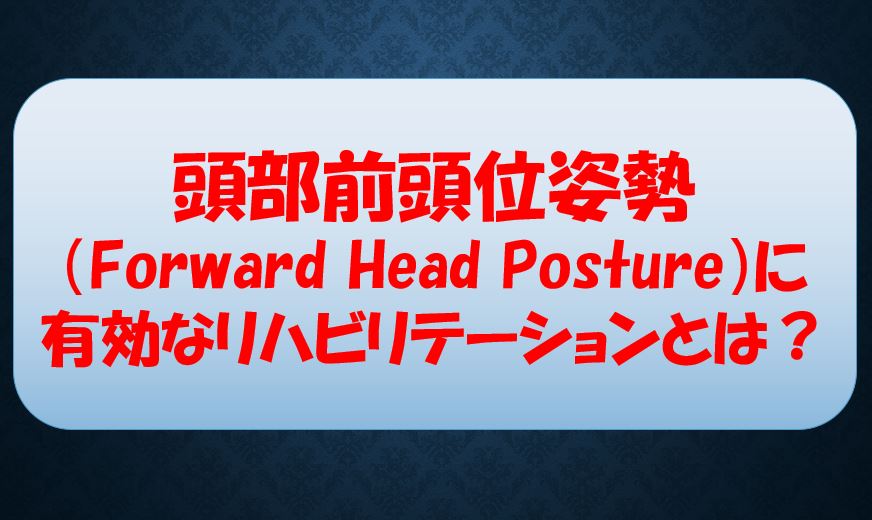こんにちは!
運動器専門のリハビリスタッフです!!
いつもお世話になります。
今回は、『頭部前頭位姿勢(Forward head posture)に有効なリハビリテーションとは?』について解説させていただきます。
現在社会ではコンピューターを使用した作業が増加しており、長時間座位による不良姿勢を呈することが多くなっております。
不良姿勢の代表例として挙げられるのが頭部前頭位姿勢(Forward head posture:FHP)です。
頭部前頭位姿勢ではアライメント不良から頭痛や頚部痛、腰痛を訴える方が多いです。
そんな中、2019年に、頭部前頭位姿勢に対するリハビリテーション検証したを論文が報告が海外で報告されております。
この論文の検証結果が気になるところです。
◆論文紹介
Randomized Controlled Trial
J Back Musculoskelet Rehabil (IF: 0.821; Q2)
. 2019;32(4):595-602.
doi: 10.3233/BMR-181228.
Upper cervical and upper thoracic spine mobilization versus deep cervical flexors exercise in individuals with forward head posture: A randomized clinical trial investigating their effectiveness
頭部前方位姿勢を持つ人における上部頸椎および上部胸椎のモビライゼーションと深部頸椎屈筋の運動。その効果を検証する無作為化臨床試験
Juchul Cho 1 2, Eunsang Lee 1, Seungwon Lee 3
- PMID: 30584118
- DOI: 10.3233/BMR-181228
Abstract
Background: Although commonly utilized treatments, no study has directly compared the effectiveness of joint mobilization and stabilization exercise in individuals with forward head posture (FHP).
背景 一般的に行われている治療法ではあるが、頭部前方位姿勢(forward head posture :FHP)の人を対象に、関節モビライゼーションとスタビライゼーション運動の効果を直接比較した研究はない。
Objective: This study aimed to investigate the effects of upper cervical and upper thoracic spine mobilization versus deep cervical flexors exercise (DCFE) in individuals with FHP.
目的 本研究では、FHP患者における上部頸椎および上部胸椎のモビライゼーションと深部頸椎屈筋運動(DCFE)の効果を調べることを目的とした。
Methods: Thirty-one participants with FHP were randomized into the mobilization (n= 15) or exercise (n= 16) group. The treatment period was 4 weeks with follow-up assessment at 4 weeks and 6 weeks after the initial examination. Outcomes assessed included the craniovertebral angle (CVA), numeric pain rating scale (NPRS), respiratory function, and the global rating of change (GRC).
方法は以下の通り。FHPを有する31名の参加者を、モビライゼーション群(n=15)またはエクササイズ群(n=16)に無作為に割り付けた。治療期間は4週間で、初診時から4週間後と6週間後にフォローアップ評価を行った。評価した結果は、頭蓋骨の角度(CVA)、数値化された疼痛評価尺度(NPRS)、呼吸機能、変化のグローバル評価(GRC)などであった。
Results: Participants in the mobilization group demonstrated significant improvements (p< 0.05) in CVA, NPRS, and respiratory function, as compared to those in the exercise group. In addition, 9 of 15 (60%) participants in the mobilization group, as compared to 4 of 16 participants (25%) in the exercise group, had a GRC score of +4 or higher.
結果は以下の通り。モビライゼーション群は、エクササイズ群と比較して、CVA、NPRS、呼吸機能に有意な改善(p<0.05)を示した。また、GRCスコアが+4以上となったのは、エクササイズ群では16人中4人(25%)であったのに対し、モビライゼーション群では15人中9人(60%)であった。
◆論文の結論
Conclusions: The combination of upper cervical and upper thoracic spine mobilization indicated better overall short-term outcomes in CVA, NPRS, respiratory function, and GRC compared with DCFE in individuals with FHP.
結論 上部頸椎と上部胸椎のモビライゼーションの組み合わせは、FHP患者のCVA、NPRS、呼吸機能、およびGRCにおいて、DCFEと比較して短期的な総合成績が良好であることを示した。
◆まとめ
上記論文では、頭部前方位姿勢(forward head posture :FHP)の人を対象に、上部頸椎および上部胸椎のモビライゼーションと深部頸椎屈筋運動の効果を調べている。
頭部前方位姿勢(FHP)31名に対して、モビライゼーション群15名と、エクササイズ群16名で比較し、週間後と6週間後にCVA(姿勢)、疼痛、呼吸機能、グローバル評価を行った。
モビライゼーション群は、エクササイズ群と比較して、CVA(姿勢)、疼痛、呼吸機能に有意な改善(p<0.05)を示した。また、グローバル評価もモビライゼーション群が有効であった。
以上のことから、頭部前方位姿勢(forward head posture :FHP)にはエクササイズも効果的ではあるが、上位頚椎および上部胸椎のモビライゼーションが有効であると思われます。
上部胸椎のモビライゼーションは下記の過去の記事でご紹介していますので参考にしていただけたらと思います。
◆胸郭モビライゼーションの方法
今回は、『頭部前頭位姿勢(Forward head posture)に有効なリハビリテーションとは?』について解説させていただきました。



